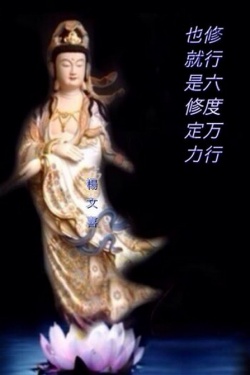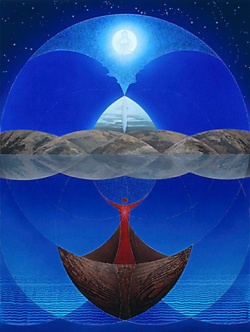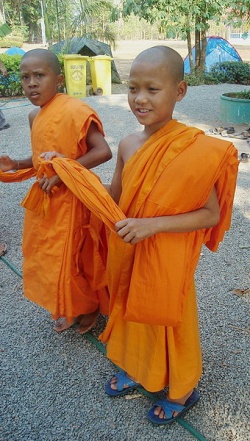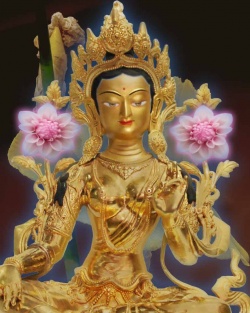Difference between revisions of "The Life of Nagarjuna by Dr. Alexander Berzin"
(Created page with " Nagarjuna (Klu-grub), together with Asanga (Thogs-med), were the two great pioneers of the Mahayana tradition. Nagarjuna transmitted the linea...") |
|||
| (3 intermediate revisions by the same user not shown) | |||
| Line 1: | Line 1: | ||
| + | <nomobile>{{DisplayImages|4021|697|2230|4428}}</nomobile> | ||
| Line 5: | Line 6: | ||
| + | [[Nagarjuna]] ([[Klu-grub]]), together with [[Asanga]] ([[Thogs-med]]), were the two great pioneers of the [[Mahayana tradition]]. | ||
| − | [[Nagarjuna]] | + | [[Nagarjuna]] transmitted the [[lineage]] teachings of the [[profound view]] of [[voidness]] from [[Manjushri]], while [[Asanga]] transmitted the [[lineage]] teachings of the extensive [[bodhisattva practices]] from [[Maitreya]]. |
| + | |||
| + | [[Nagarjuna]] was born into a [[brahmin]] [[family]] probably around the mid-first or early second century C.E. in [[South India]] in [[Vidarbha]], a {{Wiki|kingdom}} {{Wiki|lying}} in present-day {{Wiki|Maharashtra}} and [[Andhra Pradesh]]. He was predicted in various [[sutras]], such as [[The Descent into Lanka Sutra]] ([[Lan-kar gshegs-pa’i mdo]], Skt. [[Lankavatara Sutra]]). At [[birth]], a soothsayer predicted he would [[live]] only seven days, but if his [[parents]] made [[offerings]] to a hundred [[monks]], he could [[live]] to be seven years old. | ||
| + | |||
| + | Fearing for his [[life]], at age seven, his [[parents]] sent [[Nagarjuna]] to [[Nalanda Monastic University]] in [[North India]], where he met the [[Buddhist master]] [[Saraha]]. [[Saraha]] told him that if he became a renunciate and recited the [[Amitabha]] [[mantra]], he would lead a long [[life]]. [[Nagarjuna]] did so and then joined the [[monastery]], receiving the [[name]] “[[Shrimanta]].” | ||
| − | |||
At [[Nalanda]], [[Nagarjuna]] studied [[sutra]] and [[tantra]] with [[Ratnamati]] – an [[emanation of Manjushri ]]– and, with [[Saraha]], especially The [[Guhyasamaja Tantra]] ([[dPal gsang-ba ‘dus-pa’i rgyud]]). In addition, he learned [[alchemy]] from a [[brahmin]], and gained the ability to transmute {{Wiki|iron}} into {{Wiki|gold}}. Using this ability, he was [[able]] to feed the [[Nalanda]] [[monks]] during famine. Eventually, [[Nagarjuna]] became the [[abbot of Nalanda]]. There, he expelled eight thousand [[monks]] who were not keeping the [[vinaya]] [[monastic rules of discipline]] properly. He also defeated five hundred non-Buddhists in [[debate]]. | At [[Nalanda]], [[Nagarjuna]] studied [[sutra]] and [[tantra]] with [[Ratnamati]] – an [[emanation of Manjushri ]]– and, with [[Saraha]], especially The [[Guhyasamaja Tantra]] ([[dPal gsang-ba ‘dus-pa’i rgyud]]). In addition, he learned [[alchemy]] from a [[brahmin]], and gained the ability to transmute {{Wiki|iron}} into {{Wiki|gold}}. Using this ability, he was [[able]] to feed the [[Nalanda]] [[monks]] during famine. Eventually, [[Nagarjuna]] became the [[abbot of Nalanda]]. There, he expelled eight thousand [[monks]] who were not keeping the [[vinaya]] [[monastic rules of discipline]] properly. He also defeated five hundred non-Buddhists in [[debate]]. | ||
| + | |||
Two youths, who were [[emanations]] of the sons of the [[naga king]], came to [[Nalanda]]. They had about them the natural {{Wiki|fragrance}} of [[sandalwood]]. [[Nagarjuna]] asked how this was so and they confessed to him who they were. [[Nagarjuna]] then asked for [[sandalwood]] {{Wiki|scent}} for a statue of [[Tara]] and the [[nagas]]’ help in constructing [[temples]]. They returned to the [[naga realm]] and asked their father, who said he could help only if [[Nagarjuna]] came to their [[realm]] beneath the sea to teach them. [[Nagarjuna]] went, made many [[offerings]], and [[taught]] the [[nagas]]. | Two youths, who were [[emanations]] of the sons of the [[naga king]], came to [[Nalanda]]. They had about them the natural {{Wiki|fragrance}} of [[sandalwood]]. [[Nagarjuna]] asked how this was so and they confessed to him who they were. [[Nagarjuna]] then asked for [[sandalwood]] {{Wiki|scent}} for a statue of [[Tara]] and the [[nagas]]’ help in constructing [[temples]]. They returned to the [[naga realm]] and asked their father, who said he could help only if [[Nagarjuna]] came to their [[realm]] beneath the sea to teach them. [[Nagarjuna]] went, made many [[offerings]], and [[taught]] the [[nagas]]. | ||
| − | [[Nagarjuna]] had known that the [[nagas]] had The [[Hundred Thousand Verse Prajnaparamita Sutra]] (Shes-rab-kyi | + | [[Nagarjuna]] had known that the [[nagas]] had The [[Hundred Thousand Verse Prajnaparamita Sutra]] ([[Shes-rab-kyi pha-rol-tu phyin-pa stong-pa brgya-pa]], Skt. [[Shatasahasrika-prajnaparamita Sutra]]) and requested a copy. When [[Buddha]] had [[taught]] [[Prajnaparamita]], far-reaching [[discriminating]] [[awareness]] (the [[perfection of wisdom]]), the [[nagas]] had taken one version of it back to their [[realm]] for safekeeping, the [[gods]] another, and the [[yaksha]] [[lords]] of [[wealth]] yet another. |
| + | |||
| + | [[Nagarjuna]] brought back the [[hundred thousand verse]] version, although the [[nagas]] kept the last two chapters to ensure that he would return and teach them further. Later, the last two chapters were filled in with the last two chapters of The Eight Thousand Verse [[Prajnaparamita Sutra]] ([[Shes-rab-kyi pha-rol-tu phyin-pa brgyad stong-pa]], Skt. [[Ashtasahasrika-prajnaparamita Sutra]]) . This is why the last two chapters of these two recensions are the same. [[Nagarjuna]] also brought back [[naga]] clay and built many [[temples]] and [[stupas]] with it. | ||
| + | |||
| + | Once, when [[Nagarjuna]] was [[teaching]] [[Prajnaparamita]], six [[nagas]] came and formed an [[umbrella]] over his head to {{Wiki|protect}} him from the {{Wiki|sun}}. Because of this, the iconographic [[representation]] of [[Nagarjuna]] has the six [[nagas]] over his head. From this event, he got the [[name]] [[Naga]]. And from the fact that his skill in [[teaching Dharma]] went straight to the point, like the arrows of the famous archer [[Arjuna]] (the [[name]] of the [[hero]] in the [[Hindu]] classic, [[Wikipedia:Bhagavad Gita|Bhagavad Gita]]), he got the [[name]] [[Arjuna]]. Thus, he became called “[[Nagarjuna]].” | ||
| + | |||
| + | [[Nagarjuna]] later traveled to the [[Northern]] [[Island]] ([[Northern Continent]]) to teach. On the way, he met some children playing on the road. He prophesied that one of them, named [[Jetaka]], would become a [[king]]. When [[Nagarjuna]] returned from the [[Northern]] [[Island]], the boy had in fact grown up and become the [[king]] of a large {{Wiki|kingdom}} in [[South India]]. | ||
| + | |||
| + | [[Nagarjuna]] stayed with him for three years, [[teaching]] him, and then spent his last years elsewhere in his {{Wiki|kingdom}}, at [[Shri Parvata]], the [[holy mountain]] overlooking modern-day [[Nagarjunakonda]]. [[Nagarjuna]] wrote for the [[King]] A [[Precious Garland]] ([[Rin-chen ‘phreng-ba]], Skt. [[Ratnavali]]). This was the same [[king]] to whom [[Nagarjuna]] wrote A [[Letter to a Friend]] ([[bShes-pa’i spring-yig]], Skt.[[Suhrllekha]]), namely [[King]] [[Udayibhadra]] ([[bDe-spyod bzang-po]]). | ||
| − | + | Some [[Western]] [[scholars]] identify [[King]] [[Udayibhadra]] with [[King]] [[Gautamiputra Shatakarni]] (ruled 106 – 130 C.E.) of the [[Shatavahana Dynasty]] (230 B.C.E. – 199 C.E.) in present-day [[Andhra Pradesh]]. Some identify him with the next [[king]], [[Vashishtiputra Pulumayi]] (130 – 158 C.E.). It is difficult to identify him exactly. The [[Shatavahanas]] were patrons of the [[stupa]] in [[Amaravati]], where [[Buddha]] had first [[taught]] The [[Kalachakra Tantra]] and which was close to [[Shri Parvata]]. | |
| − | [[ | + | [[King]] [[Udayibhadra]] had a son, [[Kumara Shaktiman]], who wanted to become [[king]]. His mother told him that he could never become [[king]] until [[Nagarjuna]] [[died]], since [[Nagarjuna]] and the [[King]] have the same [[lifespan]]. His mother said to ask [[Nagarjuna]] for his head and since [[Nagarjuna]] was so [[compassionate]], he would undoubtedly agree to give it to him. [[Nagarjuna]] did in fact agree, but [[Kumara]] could not cut his head off with a sword. [[Nagarjuna]] said in a previous [[life]], he had killed an ant while cutting grass. |
| − | + | As a [[karmic]] result, his head could only be cut off with a blade of [[kusha grass]]. [[Kumara]] did this and [[Nagarjuna]] [[died]]. The {{Wiki|blood}} from the [[severed head]] turned into milk and the head said, “Now I will go to [[Sukhavati Pure Land]], but I will enter this [[body]] again.” [[Kumara]] took the head far away from the [[body]], but it is said that the head and the [[body]] are coming closer together each year. When they join, [[Nagarjuna]] will return and teach again. All in all, [[Nagarjuna]] lived six hundred years. | |
| − | [[ | + | Among the many texts on [[sutra]] topics that [[Nagarjuna]] wrote are his [[Collections of Reasoning]] ([[Rigs-pa’i tshogs]]), [[Collections of Praises]] ([[bsTod-pa’i tshogs]]), and [[Collections of Didactic Explanations]] ([[gTam-pa’i tshogs]]). |
| − | |||
| − | The Six Collections of | + | <poem> |
| + | The [[Six Collections of Reasoning]] ([[Rigs-tshogs drug]]) are: | ||
| − | [[Root Verses on the Middle Way]], Called " | + | [[Root Verses on the Middle Way]], Called "[[Discriminating Awareness]]" ([[dBu-ma rtsa-ba shes-rab]], Skt. [[Prajna-nama-mulamadhyamaka-karika]]) |
[[Precious Garland]] ([[Rin-chen ‘phreng-ba]], Skt. [[Ratnavali]]) | [[Precious Garland]] ([[Rin-chen ‘phreng-ba]], Skt. [[Ratnavali]]) | ||
[[Refutation of Objections]] ([[rTsod-pa zlog-pa]], Skt. [[Vigrahavyavarti]]) | [[Refutation of Objections]] ([[rTsod-pa zlog-pa]], Skt. [[Vigrahavyavarti]]) | ||
[[Seventy Verses on Voidness]] ([[sTong-nyid bdun-bcu-pa]], Skt. [[Shunyatasaptati]]) | [[Seventy Verses on Voidness]] ([[sTong-nyid bdun-bcu-pa]], Skt. [[Shunyatasaptati]]) | ||
| − | [[Sutra]] Called | + | [[Sutra]] Called “[[Finely Woven]]” ([[Zhib-mo rnam-‘thag zhes-bya-ba’i mdo]], Skt. [[Vaidalya-sutra-nama]]) |
[[Sixty Verses of Reasoning]] ([[Rigs-pa drug-cu-pa]], Skt. [[Yuktishashtika]]). | [[Sixty Verses of Reasoning]] ([[Rigs-pa drug-cu-pa]], Skt. [[Yuktishashtika]]). | ||
| + | |||
Included among his Collections of [[Praise]] are: | Included among his Collections of [[Praise]] are: | ||
| + | |||
[[Praise to the Sphere of Reality]] ([[Chos-dbyings bstod-pa]], Skt. [[Dharmadhatu-stava]]) | [[Praise to the Sphere of Reality]] ([[Chos-dbyings bstod-pa]], Skt. [[Dharmadhatu-stava]]) | ||
| Line 43: | Line 59: | ||
Included among [[Nagarjuna’s]] [[Collections of Didactic Explanations]] are: | Included among [[Nagarjuna’s]] [[Collections of Didactic Explanations]] are: | ||
| − | A Commentary on (the Two) Bodhichittas ([[Byang-chub sems-kyi ‘grel-ba]], Skt. [[Bodhichittavivarana]]) | + | A Commentary on (the Two) [[Bodhichittas]] ([[Byang-chub sems-kyi ‘grel-ba]], Skt. [[Bodhichittavivarana]]) |
{{Wiki|Anthology}} of [[Sutras]] ([[mDo kun-las btus-pa]], Skt. [[Sutrasamuccaya]]) | {{Wiki|Anthology}} of [[Sutras]] ([[mDo kun-las btus-pa]], Skt. [[Sutrasamuccaya]]) | ||
[[Letter to a Friend]] ([[bShes-pa’i spring-yig]], Skt. [[Suhrllekha]]). | [[Letter to a Friend]] ([[bShes-pa’i spring-yig]], Skt. [[Suhrllekha]]). | ||
| + | |||
Also attributed to [[Nagarjuna]] are several commentaries to The [[Guhyasamaja Tantra]], [[including]]: | Also attributed to [[Nagarjuna]] are several commentaries to The [[Guhyasamaja Tantra]], [[including]]: | ||
| − | + | ||
| − | Method for [[Meditating]] on the [[Generation Stage | + | [[Abbreviated Means for Actualization]] ([[sGrub-thabs mdor-byas]], Skt. [[Pindikrta-sadhana]]), |
| + | |||
| + | Method for [[Meditating]] on the [[Generation Stage of the Mahayoga Tantra]] [[Guhyasamaja]] Mixed with Its Textual (Sources) ([[rNal-‘byor chen-po’i rgyud dpal gsang-ba ‘dus-pa’i bskyed-pa’i rim-pa’i bsgom-pa’i thabs mdo-dang bsres-pa, Mdo-bsres]], Skt. [[Shri-guhyasamaja-mahayogatantra-utpattikrama-sadhana-sutra- melapaka]]) | ||
| + | |||
The Five Stage (Complete Stage) ([[Rim-pa lnga-pa]], Skt. [[Pancakrama]]). | The Five Stage (Complete Stage) ([[Rim-pa lnga-pa]], Skt. [[Pancakrama]]). | ||
| − | + | </poem> | |
[[Nagarjuna’s]] most famous [[disciple]] was [[Aryadeva]] (‘[[Phags-pa lha]]), author of [[Four Hundred Verse Treatise on the Actions of a Bodhisattva’s Yoga]] ([[Byang-chub sems-dpa’i rnal-‘byor spyod-pa bzhi-brgya-pa’i bstan-bcos kyi tshig-le’ur byas-pa]], Skt. [[Bodhisattvayogacarya-catu:shatakashastra-karika]]) and several commentaries on The [[Guhyasamaja Tantra]]. | [[Nagarjuna’s]] most famous [[disciple]] was [[Aryadeva]] (‘[[Phags-pa lha]]), author of [[Four Hundred Verse Treatise on the Actions of a Bodhisattva’s Yoga]] ([[Byang-chub sems-dpa’i rnal-‘byor spyod-pa bzhi-brgya-pa’i bstan-bcos kyi tshig-le’ur byas-pa]], Skt. [[Bodhisattvayogacarya-catu:shatakashastra-karika]]) and several commentaries on The [[Guhyasamaja Tantra]]. | ||
Latest revision as of 12:21, 17 February 2017
Nagarjuna (Klu-grub), together with Asanga (Thogs-med), were the two great pioneers of the Mahayana tradition.
Nagarjuna transmitted the lineage teachings of the profound view of voidness from Manjushri, while Asanga transmitted the lineage teachings of the extensive bodhisattva practices from Maitreya.
Nagarjuna was born into a brahmin family probably around the mid-first or early second century C.E. in South India in Vidarbha, a kingdom lying in present-day Maharashtra and Andhra Pradesh. He was predicted in various sutras, such as The Descent into Lanka Sutra (Lan-kar gshegs-pa’i mdo, Skt. Lankavatara Sutra). At birth, a soothsayer predicted he would live only seven days, but if his parents made offerings to a hundred monks, he could live to be seven years old.
Fearing for his life, at age seven, his parents sent Nagarjuna to Nalanda Monastic University in North India, where he met the Buddhist master Saraha. Saraha told him that if he became a renunciate and recited the Amitabha mantra, he would lead a long life. Nagarjuna did so and then joined the monastery, receiving the name “Shrimanta.”
At Nalanda, Nagarjuna studied sutra and tantra with Ratnamati – an emanation of Manjushri – and, with Saraha, especially The Guhyasamaja Tantra (dPal gsang-ba ‘dus-pa’i rgyud). In addition, he learned alchemy from a brahmin, and gained the ability to transmute iron into gold. Using this ability, he was able to feed the Nalanda monks during famine. Eventually, Nagarjuna became the abbot of Nalanda. There, he expelled eight thousand monks who were not keeping the vinaya monastic rules of discipline properly. He also defeated five hundred non-Buddhists in debate.
Two youths, who were emanations of the sons of the naga king, came to Nalanda. They had about them the natural fragrance of sandalwood. Nagarjuna asked how this was so and they confessed to him who they were. Nagarjuna then asked for sandalwood scent for a statue of Tara and the nagas’ help in constructing temples. They returned to the naga realm and asked their father, who said he could help only if Nagarjuna came to their realm beneath the sea to teach them. Nagarjuna went, made many offerings, and taught the nagas.
Nagarjuna had known that the nagas had The Hundred Thousand Verse Prajnaparamita Sutra (Shes-rab-kyi pha-rol-tu phyin-pa stong-pa brgya-pa, Skt. Shatasahasrika-prajnaparamita Sutra) and requested a copy. When Buddha had taught Prajnaparamita, far-reaching discriminating awareness (the perfection of wisdom), the nagas had taken one version of it back to their realm for safekeeping, the gods another, and the yaksha lords of wealth yet another.
Nagarjuna brought back the hundred thousand verse version, although the nagas kept the last two chapters to ensure that he would return and teach them further. Later, the last two chapters were filled in with the last two chapters of The Eight Thousand Verse Prajnaparamita Sutra (Shes-rab-kyi pha-rol-tu phyin-pa brgyad stong-pa, Skt. Ashtasahasrika-prajnaparamita Sutra) . This is why the last two chapters of these two recensions are the same. Nagarjuna also brought back naga clay and built many temples and stupas with it.
Once, when Nagarjuna was teaching Prajnaparamita, six nagas came and formed an umbrella over his head to protect him from the sun. Because of this, the iconographic representation of Nagarjuna has the six nagas over his head. From this event, he got the name Naga. And from the fact that his skill in teaching Dharma went straight to the point, like the arrows of the famous archer Arjuna (the name of the hero in the Hindu classic, Bhagavad Gita), he got the name Arjuna. Thus, he became called “Nagarjuna.”
Nagarjuna later traveled to the Northern Island (Northern Continent) to teach. On the way, he met some children playing on the road. He prophesied that one of them, named Jetaka, would become a king. When Nagarjuna returned from the Northern Island, the boy had in fact grown up and become the king of a large kingdom in South India.
Nagarjuna stayed with him for three years, teaching him, and then spent his last years elsewhere in his kingdom, at Shri Parvata, the holy mountain overlooking modern-day Nagarjunakonda. Nagarjuna wrote for the King A Precious Garland (Rin-chen ‘phreng-ba, Skt. Ratnavali). This was the same king to whom Nagarjuna wrote A Letter to a Friend (bShes-pa’i spring-yig, Skt.Suhrllekha), namely King Udayibhadra (bDe-spyod bzang-po).
Some Western scholars identify King Udayibhadra with King Gautamiputra Shatakarni (ruled 106 – 130 C.E.) of the Shatavahana Dynasty (230 B.C.E. – 199 C.E.) in present-day Andhra Pradesh. Some identify him with the next king, Vashishtiputra Pulumayi (130 – 158 C.E.). It is difficult to identify him exactly. The Shatavahanas were patrons of the stupa in Amaravati, where Buddha had first taught The Kalachakra Tantra and which was close to Shri Parvata.
King Udayibhadra had a son, Kumara Shaktiman, who wanted to become king. His mother told him that he could never become king until Nagarjuna died, since Nagarjuna and the King have the same lifespan. His mother said to ask Nagarjuna for his head and since Nagarjuna was so compassionate, he would undoubtedly agree to give it to him. Nagarjuna did in fact agree, but Kumara could not cut his head off with a sword. Nagarjuna said in a previous life, he had killed an ant while cutting grass.
As a karmic result, his head could only be cut off with a blade of kusha grass. Kumara did this and Nagarjuna died. The blood from the severed head turned into milk and the head said, “Now I will go to Sukhavati Pure Land, but I will enter this body again.” Kumara took the head far away from the body, but it is said that the head and the body are coming closer together each year. When they join, Nagarjuna will return and teach again. All in all, Nagarjuna lived six hundred years.
Among the many texts on sutra topics that Nagarjuna wrote are his Collections of Reasoning (Rigs-pa’i tshogs), Collections of Praises (bsTod-pa’i tshogs), and Collections of Didactic Explanations (gTam-pa’i tshogs).
The Six Collections of Reasoning (Rigs-tshogs drug) are:
Root Verses on the Middle Way, Called "Discriminating Awareness" (dBu-ma rtsa-ba shes-rab, Skt. Prajna-nama-mulamadhyamaka-karika)
Precious Garland (Rin-chen ‘phreng-ba, Skt. Ratnavali)
Refutation of Objections (rTsod-pa zlog-pa, Skt. Vigrahavyavarti)
Seventy Verses on Voidness (sTong-nyid bdun-bcu-pa, Skt. Shunyatasaptati)
Sutra Called “Finely Woven” (Zhib-mo rnam-‘thag zhes-bya-ba’i mdo, Skt. Vaidalya-sutra-nama)
Sixty Verses of Reasoning (Rigs-pa drug-cu-pa, Skt. Yuktishashtika).
Included among his Collections of Praise are:
Praise to the Sphere of Reality (Chos-dbyings bstod-pa, Skt. Dharmadhatu-stava)
Praise to the Deepest Truth (Don-dam-par bstod-pa, Skt. Paramartha-stava)
Praise to the Supramundane (Buddha) (‘Jig-rten-las ‘das-par bstod-pa, Skt. Lokatita-stava).
Included among Nagarjuna’s Collections of Didactic Explanations are:
A Commentary on (the Two) Bodhichittas (Byang-chub sems-kyi ‘grel-ba, Skt. Bodhichittavivarana)
Anthology of Sutras (mDo kun-las btus-pa, Skt. Sutrasamuccaya)
Letter to a Friend (bShes-pa’i spring-yig, Skt. Suhrllekha).
Also attributed to Nagarjuna are several commentaries to The Guhyasamaja Tantra, including:
Abbreviated Means for Actualization (sGrub-thabs mdor-byas, Skt. Pindikrta-sadhana),
Method for Meditating on the Generation Stage of the Mahayoga Tantra Guhyasamaja Mixed with Its Textual (Sources) (rNal-‘byor chen-po’i rgyud dpal gsang-ba ‘dus-pa’i bskyed-pa’i rim-pa’i bsgom-pa’i thabs mdo-dang bsres-pa, Mdo-bsres, Skt. Shri-guhyasamaja-mahayogatantra-utpattikrama-sadhana-sutra- melapaka)
The Five Stage (Complete Stage) (Rim-pa lnga-pa, Skt. Pancakrama).
Nagarjuna’s most famous disciple was Aryadeva (‘Phags-pa lha), author of Four Hundred Verse Treatise on the Actions of a Bodhisattva’s Yoga (Byang-chub sems-dpa’i rnal-‘byor spyod-pa bzhi-brgya-pa’i bstan-bcos kyi tshig-le’ur byas-pa, Skt. Bodhisattvayogacarya-catu:shatakashastra-karika) and several commentaries on The Guhyasamaja Tantra.
Source
https://studybuddhism.com/en/tibetan-buddhism/spiritual-teachers/nagarjuna/the-life-of-nagarjuna



